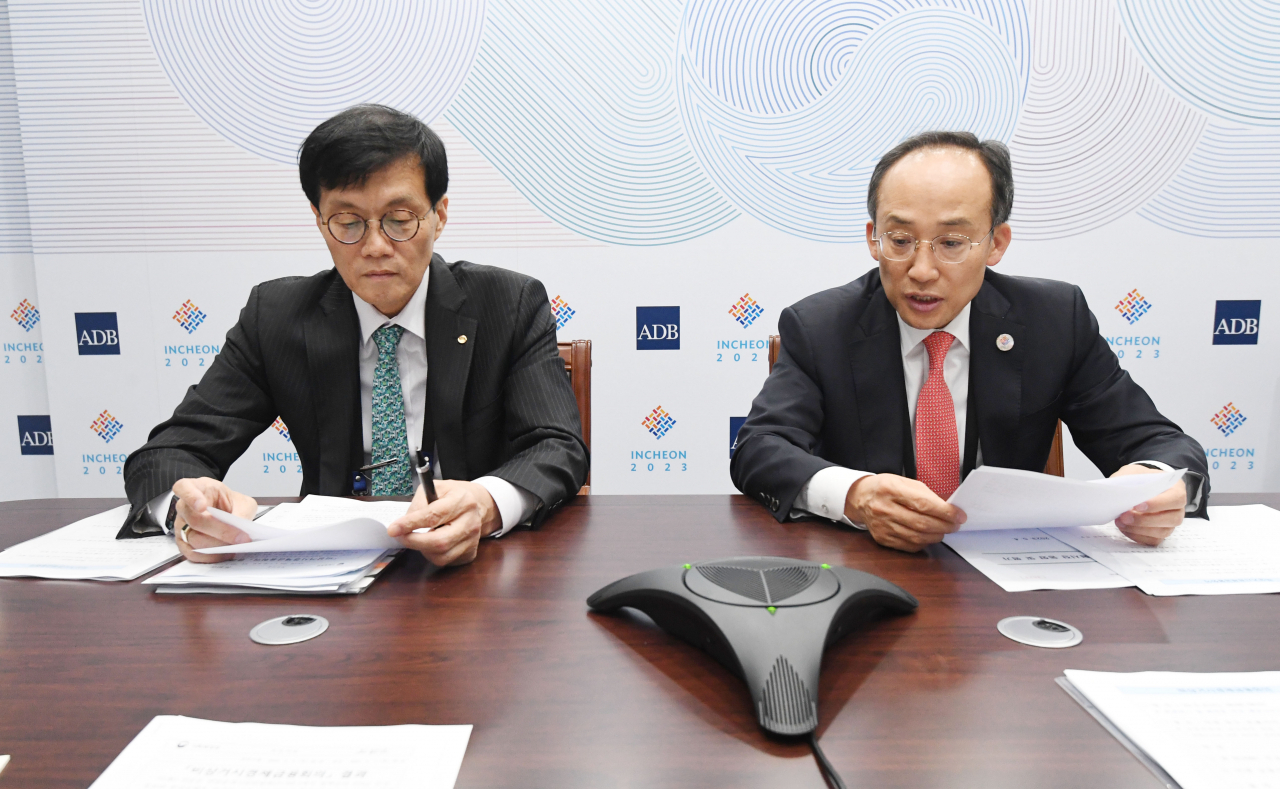 |
BOK Governor Rhee Chang-yong (left) Finance Minister Choo Kyung-ho speak at a meeting held at Songdo Convensia, Incheon, Thursday. (Yonhap) |
The rate gap between South Korea and the United States has reached an all-time high, raising concerns over the local financial market due to higher volatility and uncertainty, Finance Minister Choo Kyung-ho said on Thursday.
The US Federal Reserve lifted its base rate by 25 basis points on Thursday, widening the rate gap between Korea and the US up to an unprecedented figure of 1.75 percentage points.
"In a situation where the interest rate gap is widened, there is a possibility of increasing uncertainty in the financial and foreign exchange markets, as well as concerns over increased volatility due to market disturbances and concentration," Choo said during a meeting with BOK Governor Rhee Chang-yong and other financial officials on Thursday.
He further added that closer monitoring of the economy is needed in such situations.
The US Federal Open Market Committee went for three consecutive quarter-point raises, raising the target interest rate from 4.75-5 percent to 5-5.25 percent, while Korea's base rate stands at 3.5 percent.
Though Fed Chair Jerome Powell stressed a rate cut is not on the table yet, the market deemed the Fed’s rate hike cycle to have wrapped up.
“The FOMC statement shows that the era of consecutive rate hikes has ended, and the Fed will take some time to monitor the effects of previous rate raises and the path of the banking crisis," Kang Seung-won, analyst from NH Investment & Securities said.
The BOK agreed with the market's interpretation.
“The decision seems to show that the Fed has neared the end of its rate hike cycle,” BOK Deputy Governor Lee Seung-heon said in a meeting held Thursday, pledging to closely monitor the situation as volatility could escalate.
With the market deeming the Fed will not likely further raise the base rate, the currency has remained relatively stable. The Korean won against the dollar closed at 1,322.8 won, down 15.4 won from the previous session's close.
"The Fed implying a conditional halt in rate cuts will have a positive impact on the financial and foreign exchange markets," the finance minister said.
Concerns exist for South Korea as the quarter-point move has brought up the rate differentials of Korea and the US to 1.75 percentage points, surpassing the previous record gap of 1.5 percentage points set in 2000.
Yet, Hwang Sei-woon, senior research fellow at the Korea Capital Market Institute, viewed the gap to be at a “manageable” level.
“The widened gap may increase pressure. But this does not directly lead to the leakage of foreign funds,” Hwang said.
“Of course we have to keep an eye on the widened gap because, in the case of a huge credit event, it will trigger an outflow. But the market deems Korea can manage the gap as long as it remains below 2 percent.”
Eyes are on the BOK’s next steps. The central bank is set to hold its next rate-setting meeting at the end of May. Until the meeting takes place, the key rate gap between Korea and the US will remain at its widest ever.
Though the BOK will be pressured to raise its rate to have it match that of the Fed, it will have some room to breathe as the Fed is not likely to raise its rate further for the time being.
“With the Fed maintaining its decision on the key rate for the future, the BOK is likely to maintain its previous forward guidance," said Min Ji-hee, an analyst at Mirae Asset Securities. The central bank has repeatedly stressed that discussing a pivot is premature, she added.
Hwang also viewed a rate cut will not come any time soon.
“The BOK will hold its rate until the end of the year,” Hwang said. “Korea is not yet at a stage to discuss a rate cut and the central bank’s control on inflation will continue.”.







